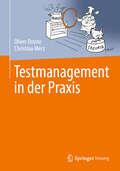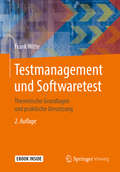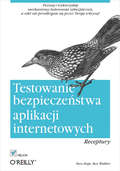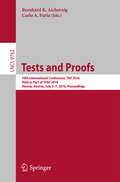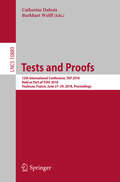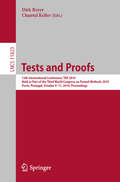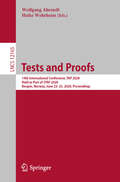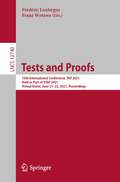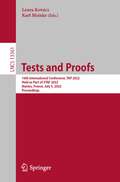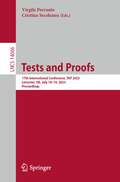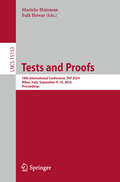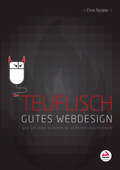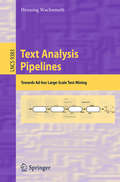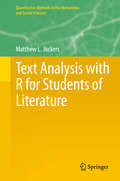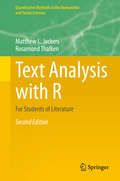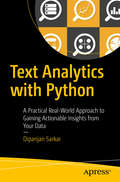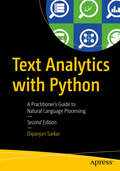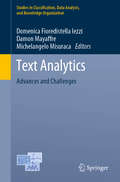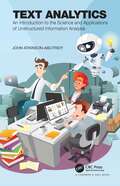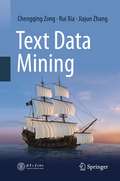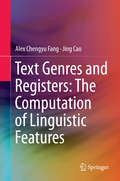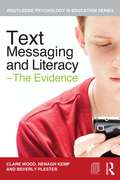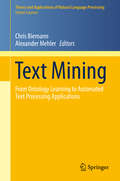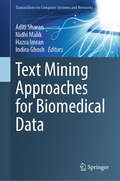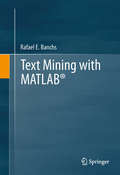- Table View
- List View
Testmanagement in der Praxis
by Oliver Droste Christina MerzDieses Praxisbuch soll ein Handwerkszeug für Testmanager von Software-Implementierungsprojekten sein. Es richtet sich zudem an Projektleiter und alle, die sich mit dem Thema Testmanagement auseinandersetzen wollen oder müssen. Die Autoren haben oft festgestellt, dass in Projekten viele Vorgaben zum Testmanagement existieren, die praxisfern sind und zudem nur mit viel bürokratischem Aufwand umgesetzt werden können. Die Energie wird so oftmals in die Umsetzung eines komplexen Rahmenwerks gesteckt, ohne einen quantifizierbaren Nutzen zu stiften.Hier setzt dieses Buch an. Mit Fokussierung auf das Wesentliche, was für eine erfolgreiche Umsetzung eines Testvorhabens relevant ist, soll es auch als Sparringspartner dienen und dem Testmanager bei seiner Standortbestimmung Hilfe und Unterstützung geben sowie Denkanstöße auslösen.Der Aufbau dieses Buches orientiert sich am Lebenszyklus eines klassischen Projektes (V-Modell / Wasserfall-Modell). Der Praxisbezug wird von den Autoren anhand eines fiktiven Projektes hergestellt, welches mit tatsächlichen Erfahrungen ergänzt wird.
Testmanagement und Softwaretest: Theoretische Grundlagen und praktische Umsetzung
by Frank WitteDas Buch gibt konkrete Tipps zur erfolgreichen Umsetzung von Softwaretests und effizientem Testmanagement. Dabei verbindet der Autor theoretische Grundlagen mit betrieblicher Realität zur Anwendung in der Praxis. Er gibt hilfreiche Hinweise, welche Herausforderungen beim Test von Software bestehen, wo es Fallstricke gibt und was zu beachten ist, um sie zu vermeiden.
Testowanie bezpieczeństwa aplikacji internetowych (in Polish)
by Paco Hope Ben WaltherKsika Testowanie bezpieczestwa aplikacji internetowych. Receptury to napisany zrozumiaym jzykiem podrcznik, dziki ktremu szybko poznasz mechanizmy testowania zabezpiecze.
Tests and Proofs
by Bernhard K. Aichernig Carlo A. FuriaThis book constitutes the refereed proceedings of the 10th International Conference on Tests and Proofs, TAP 2016, held as part of STAF 2016, in Vienna, Austria, in July 2016. The 8 full papers, 2 short papers, and 1 tool demonstration paper presented in this volume were carefully reviewed and selected from 19 submissions. The book also contains one invited talk in full-paper length. The TAP conference promotes research in verification and formal methods that targets the interplay of proofs and testing: the advancement of techniques of each kind and their combination, with the ultimate goal of improving software and system dependability.
Tests and Proofs: 12th International Conference, TAP 2018, Held as Part of STAF 2018, Toulouse, France, June 27-29, 2018, Proceedings (Lecture Notes in Computer Science #10889)
by Catherine Dubois Burkhart WolffThis book constitutes the refereed proceedings of the 12th International Conference on Tests and Proofs, TAP 2018, held as part of STAF 2018, in Toulouse, France, in June 2018. The 8 regular papers, 2 short papers, 1 invited paper and 1 invited tutorial presented in this volume were carefully reviewed and selected from 18 submissions. The TAP conference promotes research in verification and formal methods that targets the interplay of proofs and testing: the advancement of techniques of each kind and their combination, with the ultimate goal of improving software and system dependability.
Tests and Proofs: 13th International Conference, TAP 2019, Held as Part of the Third World Congress on Formal Methods 2019, Porto, Portugal, October 9–11, 2019, Proceedings (Lecture Notes in Computer Science #11823)
by Dirk Beyer Chantal KellerThis book constitutes the refereed proceedings of the 13th International Conference on Tests and Proofs, TAP 2019, held as part of the Third World Congress on Formal Methods 2019, Porto, Portugal, in October 2019. The 10 regular papers and 2 invited paper presented in this volume were carefully reviewed and selected from 19 submissions. The TAP conference promotes research in verification and formal methods that targets the interplay of proofs and testing: the advancement of techniques of each kind and their combination, with the ultimate goal of improving software and system dependability.
Tests and Proofs: 14th International Conference, TAP 2020, Held as Part of STAF 2020, Bergen, Norway, June 22–23, 2020, Proceedings (Lecture Notes in Computer Science #12165)
by Heike Wehrheim Wolfgang AhrendtThis book constitutes the refereed proceedings of the 14th International Conference on Tests and Proofs, TAP 2020, held as part of the 4th World Congress on Formal Methods 2020, Bergen, Norway, in June 2020. The 7 regular papers, 1 short paper and 2 demonstration papers presented in this volume were carefully reviewed and selected from 209 submissions. The TAP conference promotes research in verification and formal methods that targets the interplay of proofs and testing: the advancement of techniques of each kind and their combination, with the ultimate goal of improving software and system dependability.
Tests and Proofs: 15th International Conference, TAP 2021, Held as Part of STAF 2021, Virtual Event, June 21–22, 2021, Proceedings (Lecture Notes in Computer Science #12740)
by Franz Wotawa Frédéric LoulergueThis book constitutes the proceedings of the 15th International Conference on Tests and Proofs, TAP 2021, which was held as part of Software Technologies: Applications and Foundations, STAF 2021, and took place online during June 12-25, 2021.The 6 full papers included in this volume were carefully reviewed and selected from 10 submissions. They were organized in topical sections on learning, test resource allocation and benchmarks and on testing.
Tests and Proofs: 16th International Conference, TAP 2022, Held as Part of STAF 2022, Nantes, France, July 5, 2022, Proceedings (Lecture Notes in Computer Science #13361)
by Karl Meinke Laura KovácsThis book constitutes the proceedings of the 16th International Conference on Tests and Proofs, TAP 2022, which was held as part of Software Technologies: Applications and Foundations, STAF 2022, and took place in Nantes, France in July 2022.The 6 full papers together with 1 invited extended abstract included in this volume were carefully reviewed and selected from 11 submissions. They were organized in topical sections on formal analysis, and proofs, and effective testing.
Tests and Proofs: 17th International Conference, TAP 2023, Leicester, UK, July 18–19, 2023, Proceedings (Lecture Notes in Computer Science #14066)
by Cristina Seceleanu Virgile PrevostoThis book constitutes the proceedings of the 17th International Conference, TAP 2023, as part of STAF 2023, a federation of conferences on Software Technologies, Applications and Foundations, which includes two more conferences besides TAP: ICGT (International Conference on Graph Transformations), and ECMFA (European Conference on Modelling Foundations and Applications) in Leicester, UK, in July 2023. The 8 full papers together with 2 short papers included in this volume were carefully reviewed and selected from 14 submissions. They were organized in topical sections on Low-level Code Verification, Formal Models, Model-based test generation, and Abstraction and Refinement.
Tests and Proofs: 18th International Conference, TAP 2024, Milan, Italy, September 9–10, 2024, Proceedings (Lecture Notes in Computer Science #15153)
by Marieke Huisman Falk HowarThis book constitutes the proceedings of the 18th International Conference on Tests and Proofs, TAP 2024. TAP 2024 took place in Milan, Italy, on September 9 and 10, 2024 as part of the Formal Methods symposium (FM 2024), which included four more co-located conferences besides TAP: FMICS (Formal Methods in Industrial Critical Systems), LOPSTR (In ternational Symposium on Logic-based Program Synthesis and Transformation), PPDP (International Symposium on Principles and Practice of Declarative Pro gramming), and FACS (International Conference on Formal Aspects of Compo nent Software. The 7 full papers together with 1 short paper included in this volume were carefully reviewed and selected from 14 submissions. TAP’s scope encompasses many aspects of verification technology, including foundational work, tool development, and empirical research.
Teuflisch gutes Webdesign: Wie Sie Ihre Kunden in Versuchung führen
by Chris Nodder»Lesen Sie besser dieses Buch, bevor Sie jemand über den Tisch zieht. Wenn diese Angst nicht reicht, wird Gier vielleicht den Zweck erfüllen: Durch die Regeln dieses Buchs wird jede Website eine Menge Geld machen, selbst wenn Sie nicht vollständig dem Bösen verfallen.« Jakob Nielsen, Autor von »Designing Web Usability« und »Mobile Usability« »Aufschlussreich, lustig und spannend … Dieses Buch zeigt Ihnen, wie Sie schon ausgetrickst worden sind und, noch viel besser, wie Sie selbst andere Menschen dazu bringen, etwas zu tun – sei es zum Bösen oder (wenn es denn unbedingt sein muss) zum Guten.« Bruce »Tog« Tognazzini, Mitinhaber der Nielsen Norman Group und ehemaliger Apple-Mitarbeiter Nr. 66 Erfolgreichere Websites durch die Kunst der Verführung Ihre Kunden sollen Ihre Website lieben? Sich dort so richtig wohlfühlen – und dabei das tun, was Sie von ihnen möchten? In einer furiosen Mischung aus Psychologie, Marketing und Design zeigt Ihnen Chris Nodder, wie Sie das erreichen. Die einfach umzusetzenden Designmuster, die er Ihnen an die Hand gibt, bauen auf den kleinen Schwächen auf, die wir alle haben: Wir möchten dazugehören, uns nicht allzu sehr anstrengen, Schnäppchen machen, nicht Nein sagen müssen und vieles mehr. An unzähligen Beispielen aus allen Schlupfwinkeln des Internets lernen Sie, wie Sie die Usability Ihrer Website verbessern, indem Sie diese Schwächen berücksichtigen – oder wie Sie Ihre Kunden dadurch verleiten können. Der Erfolg ist Ihnen in jedem Fall sicher, es liegt also an Ihnen: Wie werden Sie Ihr neues Wissen einsetzen? Zum Guten oder zum Bösen? Stolz: Den Wunsch nach Zugehörigkeit nutzen Trägheit: Verhalten durch Auswahlhilfen lenken Völlerei: Mit Belohnungen arbeiten Zorn: Ärger vermeiden und entschärfen Neid: Begehrlichkeiten wecken Lust: Sympathie erzeugen und erhalten Gier: Gewünschtes Verhalten bestärken
Text Analysis Pipelines
by Henning WachsmuthThis monograph proposes a comprehensive and fully automatic approach to designing text analysis pipelines for arbitrary information needs that are optimal in terms of run-time efficiency and that robustly mine relevant information from text of any kind. Based on state-of-the-art techniques from machine learning and other areas of artificial intelligence, novel pipeline construction and execution algorithms are developed and implemented in prototypical software. Formal analyses of the algorithms and extensive empirical experiments underline that the proposed approach represents an essential step towards the ad-hoc use of text mining in web search and big data analytics. Both web search and big data analytics aim to fulfill peoples' needs for information in an adhoc manner. The information sought for is often hidden in large amounts of natural language text. Instead of simply returning links to potentially relevant texts, leading search and analytics engines have started to directly mine relevant information from the texts. To this end, they execute text analysis pipelines that may consist of several complex information-extraction and text-classification stages. Due to practical requirements of efficiency and robustness, however, the use of text mining has so far been limited to anticipated information needs that can be fulfilled with rather simple, manually constructed pipelines.
Text Analysis with R for Students of Literature
by Matthew L. JockersText Analysis with R for Students of Literature is written with students and scholars of literature in mind but will be applicable to other humanists and social scientists wishing to extend their methodological tool kit to include quantitative and computational approaches to the study of text. Computation provides access to information in text that we simply cannot gather using traditional qualitative methods of close reading and human synthesis. Text Analysis with R for Students of Literature provides a practical introduction to computational text analysis using the open source programming language R. R is extremely popular throughout the sciences and because of its accessibility, R is now used increasingly in other research areas. Readers begin working with text right away and each chapter works through a new technique or process such that readers gain a broad exposure to core R procedures and a basic understanding of the possibilities of computational text analysis at both the micro and macro scale. Each chapter builds on the previous as readers move from small scale "microanalysis" of single texts to large scale "macroanalysis" of text corpora, and each chapter concludes with a set of practice exercises that reinforce and expand upon the chapter lessons. The book's focus is on making the technical palatable and making the technical useful and immediately gratifying.
Text Analysis with R: For Students of Literature (Quantitative Methods in the Humanities and Social Sciences)
by Matthew L. Jockers Rosamond ThalkenNow in its second edition, Text Analysis with R provides a practical introduction to computational text analysis using the open source programming language R. R is an extremely popular programming language, used throughout the sciences; due to its accessibility, R is now used increasingly in other research areas. In this volume, readers immediately begin working with text, and each chapter examines a new technique or process, allowing readers to obtain a broad exposure to core R procedures and a fundamental understanding of the possibilities of computational text analysis at both the micro and the macro scale. Each chapter builds on its predecessor as readers move from small scale “microanalysis” of single texts to large scale “macroanalysis” of text corpora, and each concludes with a set of practice exercises that reinforce and expand upon the chapter lessons. The book’s focus is on making the technical palatable and making the technical useful and immediately gratifying. Text Analysis with R is written with students and scholars of literature in mind but will be applicable to other humanists and social scientists wishing to extend their methodological toolkit to include quantitative and computational approaches to the study of text. Computation provides access to information in text that readers simply cannot gather using traditional qualitative methods of close reading and human synthesis. This new edition features two new chapters: one that introduces dplyr and tidyr in the context of parsing and analyzing dramatic texts to extract speaker and receiver data, and one on sentiment analysis using the syuzhet package. It is also filled with updated material in every chapter to integrate new developments in the field, current practices in R style, and the use of more efficient algorithms.
Text Analytics with Python
by Dipanjan SarkarDerive useful insights from your data using Python. You will learn both basic and advanced concepts, including text and language syntax, structure, and semantics. You will focus on algorithms and techniques, such as text classification, clustering, topic modeling, and text summarization. Text Analytics with Python teaches you the techniques related to natural language processing and text analytics, and you will gain the skills to know which technique is best suited to solve a particular problem. You will look at each technique and algorithm with both a bird's eye view to understand how it can be used as well as with a microscopic view to understand the mathematical concepts and to implement them to solve your own problems. What You Will Learn: Understand the major concepts and techniques of natural language processing (NLP) and text analytics, including syntax and structure Build a text classification system to categorize news articles, analyze app or game reviews using topic modeling and text summarization, and cluster popular movie synopses and analyze the sentiment of movie reviews Implement Python and popular open source libraries in NLP and text analytics, such as the natural language toolkit (nltk), gensim, scikit-learn, spaCy and Pattern Who This Book Is For : IT professionals, analysts, developers, linguistic experts, data scientists, and anyone with a keen interest in linguistics, analytics, and generating insights from textual data
Text Analytics with Python: A Practitioner's Guide to Natural Language Processing
by Dipanjan SarkarLeverage Natural Language Processing (NLP) in Python and learn how to set up your own robust environment for performing text analytics. This second edition has gone through a major revamp and introduces several significant changes and new topics based on the recent trends in NLP. You’ll see how to use the latest state-of-the-art frameworks in NLP, coupled with machine learning and deep learning models for supervised sentiment analysis powered by Python to solve actual case studies. Start by reviewing Python for NLP fundamentals on strings and text data and move on to engineering representation methods for text data, including both traditional statistical models and newer deep learning-based embedding models. Improved techniques and new methods around parsing and processing text are discussed as well. Text summarization and topic models have been overhauled so the book showcases how to build, tune, and interpret topic models in the context of an interest dataset on NIPS conference papers. Additionally, the book covers text similarity techniques with a real-world example of movie recommenders, along with sentiment analysis using supervised and unsupervised techniques.There is also a chapter dedicated to semantic analysis where you’ll see how to build your own named entity recognition (NER) system from scratch. While the overall structure of the book remains the same, the entire code base, modules, and chapters has been updated to the latest Python 3.x release.What You'll Learn• Understand NLP and text syntax, semantics and structure• Discover text cleaning and feature engineering• Review text classification and text clustering • Assess text summarization and topic models• Study deep learning for NLPWho This Book Is ForIT professionals, data analysts, developers, linguistic experts, data scientists and engineers and basically anyone with a keen interest in linguistics, analytics and generating insights from textual data.
Text Analytics: Advances and Challenges (Studies in Classification, Data Analysis, and Knowledge Organization)
by Domenica Fioredistella Iezzi Damon Mayaffre Michelangelo MisuracaFocusing on methodologies, applications and challenges of textual data analysis and related fields, this book gathers selected and peer-reviewed contributions presented at the 14th International Conference on Statistical Analysis of Textual Data (JADT 2018), held in Rome, Italy, on June 12-15, 2018. Statistical analysis of textual data is a multidisciplinary field of research that has been mainly fostered by statistics, linguistics, mathematics and computer science. The respective sections of the book focus on techniques, methods and models for text analytics, dictionaries and specific languages, multilingual text analysis, and the applications of text analytics. The interdisciplinary contributions cover topics including text mining, text analytics, network text analysis, information extraction, sentiment analysis, web mining, social media analysis, corpus and quantitative linguistics, statistical and computational methods, and textual data in sociology, psychology, politics, law and marketing.
Text Analytics: An Introduction to the Science and Applications of Unstructured Information Analysis
by John Atkinson-AbutridyText Analytics: An Introduction to the Science and Applications of Unstructured Information Analysis is a concise and accessible introduction to the science and applications of text analytics (or text mining), which enables automatic knowledge discovery from unstructured information sources, for both industrial and academic purposes. The book introduces the main concepts, models, and computational techniques that enable the reader to solve real decision-making problems arising from textual and/or documentary sources. Features: Easy-to-follow step-by-step concepts and methods Every chapter is introduced in a very gentle and intuitive way so students can understand the WHYs, WHAT-IFs, WHAT-IS-THIS-FORs, HOWs, etc. by themselves Practical programming exercises in Python for each chapter Includes theory and practice for every chapter, summaries, practical coding exercises for target problems, QA, and sample code and data available for download at https://www.routledge.com/Atkinson-Abutridy/p/book/9781032249797
Text Data Mining
by Jiajun Zhang Chengqing Zong Rui XiaThis book discusses various aspects of text data mining. Unlike other books that focus on machine learning or databases, it approaches text data mining from a natural language processing (NLP) perspective. The book offers a detailed introduction to the fundamental theories and methods of text data mining, ranging from pre-processing (for both Chinese and English texts), text representation and feature selection, to text classification and text clustering. It also presents the predominant applications of text data mining, for example, topic modeling, sentiment analysis and opinion mining, topic detection and tracking, information extraction, and automatic text summarization. Bringing all the related concepts and algorithms together, it offers a comprehensive, authoritative and coherent overview. Written by three leading experts, it is valuable both as a textbook and as a reference resource for students, researchers and practitioners interested in text data mining. It can also be used for classes on text data mining or NLP.
Text Genres and Registers: The Computation of Linguistic Features
by Alex Chengyu Fang Jing CaoThis book is a description of some of the most recent advances in text classification as part of a concerted effort to achieve computer understanding of human language. In particular, it addresses state-of-the-art developments in the computation of higher-level linguistic features, ranging from etymology to grammar and syntax for the practical task of text classification according to genres, registers and subject domains. Serving as a bridge between computational methods and sophisticated linguistic analysis, this book will be of particular interest to academics and students of computational linguistics as well as professionals in natural language engineering.
Text Messaging and Literacy – The Evidence
by Clare Wood Nenagh Kemp Beverly Plester"Well thought out and timely. This is the leading group in the world working on texting and literacy, and they have a strong track record of publications. It would also be the first book, as they say, to deal with the subject at an academic level. The focus on education is important, as this is where most of the anxieties lie. It will be a major step forward in creating a new climate." Professor David Crystal, author of The Cambridge Encyclopaedia of Language and The Cambridge Encyclopaedia of the English Language, Television consultant and presenter As children are given mobile phones at increasingly younger ages, there is considerable media coverage of claims that mobile phones, and text messaging in particular, are responsible for declining levels of literacy in children and young people. Such claims are often adopted wholesale by teachers and parents, despite the fact that there is an empirical literature which has failed to find a basis to these claims, and to the contrary has found that text messaging is supporting children’s literacy skills. Written by leading international researchers Text Messaging and Literacy presents an overview and discussion of the academic evidence for and against use of text messaging and mobile phones in supporting literate activity and discusses what conclusions we can and should draw about the impact of mobile phones, and their potential role in education. Areas covered include: the rise of texting and media reactions; children’s reading, spelling and texting; text messaging of children with language difficulties; using mobile phones for literacy development; texting and literacy skills in adolescents and adults; spelling and grammar in texting and beyond; the future of texting. In challenging existing assumptions the authors present the cutting edge of international research, highlighting their own studies involving children of all ages, adolescents and adults. This ground breaking book is essential reading for both researchers and students in education, educational psychology, literacy and new media and it’s impact on learning.
Text Mining
by Alexander Mehler Chris BiemannThis book comprises a set of articles that specify the methodology of text mining, describe the creation of lexical resources in the framework of text mining and use text mining for various tasks in natural language processing (NLP). The analysis of large amounts of textual data is a prerequisite to build lexical resources such as dictionaries and ontologies and also has direct applications in automated text processing in fields such as history, healthcare and mobile applications, just to name a few. This volume gives an update in terms of the recent gains in text mining methods and reflects the most recent achievements with respect to the automatic build-up of large lexical resources. It addresses researchers that already perform text mining, and those who want to enrich their battery of methods. Selected articles can be used to support graduate-level teaching. The book is suitable for all readers that completed undergraduate studies of computational linguistics, quantitative linguistics, computer science and computational humanities. It assumes basic knowledge of computer science and corpus processing as well as of statistics.
Text Mining Approaches for Biomedical Data (Transactions on Computer Systems and Networks)
by Aditi Sharan Nidhi Malik Hazra Imran Indira GhoshThe book 'Text Mining Approaches for Biomedical Data' delves into the fascinating realm of text mining in healthcare. It provides an in-depth understanding of how Artificial Intelligence (AI) and Machine Learning (ML) are revolutionizing healthcare research and patient care. The book covers a wide range of topics such as mining textual data in biomedical and health databases, analyzing literature and clinical trials, and demonstrating various applications of text mining in healthcare. This book is a guide for effectively representing textual data using vectors, knowledge graphs, and other advanced techniques. It covers various text mining applications, building descriptive and predictive models, and evaluating them. Additionally, it includes building machine learning models using textual data, covering statistical and deep learning approaches. This book is designed to be a valuable reference for computer science professionals, researchers in the biomedical field, and clinicians. It provides practical guidance and promotes collaboration between different disciplines. Therefore, it is a must-read for anyone who is interested in the intersection of text mining and healthcare.
Text Mining with MATLAB®
by Rafael E. BanchsText Mining with MATLAB provides a comprehensive introduction to text mining using MATLAB. It's designed to help text mining practitioners, as well as those with little-to-no experience with text mining in general, familiarize themselves with MATLAB and its complex applications. The first part provides an introduction to basic procedures for handling and operating with text strings. Then, it reviews major mathematical modeling approaches. Statistical and geometrical models are also described along with main dimensionality reduction methods. Finally, it presents some specific applications such as document clustering, classification, search and terminology extraction. All descriptions presented are supported with practical examples that are fully reproducible. Further reading, as well as additional exercises and projects, are proposed at the end of each chapter for those readers interested in conducting further experimentation.
